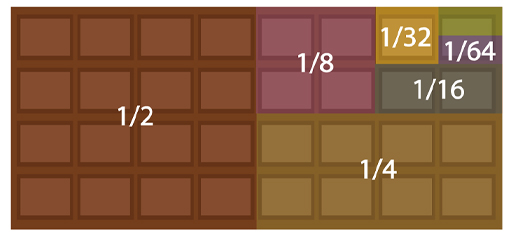5.2 Dividing into infinitely many pieces
Here’s an illustration of a finite object being divided into infinitely many pieces: picture a chocolate bar, and an obstinate mathematician who eats half of what’s left every day. On day one they eat half of the bar; on day two they eat a quarter of it; on day three they eat an eighth; on day four they eat a sixteenth, and so on. Because you can always divide a fraction in two, this process never ends (though before long, the mathematician isn’t eating much chocolate per day).
Now, when you come to add up the infinite string of fractions in this scenario, hopefully it’s clear that these fractions add up to 1.
1 can be imagined here as the whole bar of chocolate you started with. This illustrates that you can have an infinite addition which gives a finite answer. This seems unexpected at first – so often the case where infinity is concerned! Now, Zeno’s paradox may cease to be a paradox at all, if the infinite sum of all those tiny distances the tortoise travels has a finite answer (the point at which Achilles passes the tortoise).
What do you need to make an infinite addition give a finite answer? This is where the work of Newton and Leibniz helps us. They invented ‘calculus’ – arguably the most powerful piece of mathematics ever gifted to the sciences. You could fill many books describing calculus, and it’s a topic for extensive study in itself. This course will give a quick flavour of what calculus is and what it allows us to do.

